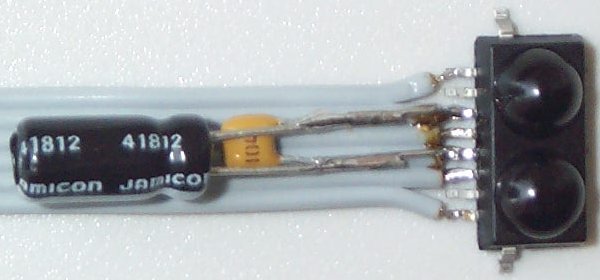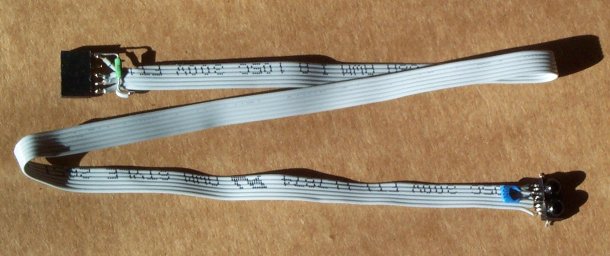

Many of todays motherboard have option to connect IrDA module for infrared communication. But this module is not standard equipment and isn't easy to find him. I examine option to build my own module and I discover, that only few parts are needed. It's needed only standard IrDA transceiver and few parts discovered from datasheet. Majority of circuit is build-in in motherboard chipset. In the concrete covertor from serial signal to IrDA pulses. Pulses from IrDA transceiver are negated!

Like a IrDA transceiver is used chip HSDL1001 from Agilent Technologies (Hewlett Packard). It is available in Czech market GM Electronic. Next I was use resistor 10R/0.5W, which limits output current to infra LED. On the feed must be used blocking capacitor 100nF close to HSDL1001. If on the feed will be interference or cable will be longer it's needed electrolytic capacitor. I was used 47uF/10V. Like a connector to motherboard is used 5 pins SIL pin terminal. I was use flat computer cable from old floppy. Lenght can't be longer than 50cm. I have information from some people, that when you use shielded cable, you can have longer cable. InfraRed communicatoin would operate to about 150cm.
Circuit HSDL1001 is in SMD case and therefore is needed a little facility. I was built before problem how-to solder four SMD pins with using standard transformer soldering iron and not to connect pins together. I was get flat cable and cut 6 wires, leave them together, razor isolation about 1 mm and plate them with tin. Outer wires I was divorce in lenght about 5 mm (See picture). Now I was get HSDL1001, put the flat cable to pins and put the hot soldering iron to upper side of wires. First I was solder middle 4 wires and next outer two wires. Lower side of wires was soldered to pins of IR part. When you connect some of pins, you can use flux (colophony) or vacuum pump to disconnect them. Next you must solder ceramic capacitor to wires. You can bend down end of pin, place on the wire and solder. It's needed to work carefully and not connect pins. Electrolytic capacitor is soldered to pins of ceramic capacitor. It's better to have not much hot soldering iron. Next we must solder resistor and wires to SIL connector. Some manufacturers have other wiring of connector. You must look to the User's manual of your motherboard and compare wiring. My wiring diagram is mostly used by Abit, ASUS, AOpen, MSI and maybe other manufacturers.
In a BIOS you must activate infrared port, usually SIR (Serial Infra Red)
for COM2. You must use IrDA mode or HPSIR.
Some BIOSes have additional options. Many times works default settings.
When you have options TxD, RxD - HiLo, HiHi, LoHi, LoLo, I recommend
to NOT change options. In some Award BIOSes is marked negative.
When you manipulate with these settings, you can DESTROY IrDA transceiver
or resistor. It's designed for pulses, not for continual lighting.
You can recognize it by smell. Transceiver and resistor will be very hot too.
In dark you will see dark red light from one transceiver lens.
I was test it and components was not destryed ;-)
Next you can have option Duplex HALF/FULL. Leave it at HALF.
Option "Transmit Delay" was not effect on my equipment. Leave it at default.
Like a operational system you can you whatever with IrDA support.
For example Win98, Win2000 or Linux.
After activation in bios (with or without connected module) your OS would find
new IrDA device. For example in Win98 are required drivers from installation
CDROM. After correct installation you will see a small infra icon in a traybar.
This icon signalling status of IrDA device. When you approach some other IrDA
device, Windows would automatically tells about finded device for example
mobile phone NOKIA 6210, or printer HP Laserjet4 and they would wants drivers
from you.
At linux you must have IrDA subsystem compiled at kernel, respectively
like a kernel module.
In a file /etc/modules.conf I have this:
alias tty-ldisc-11 irtty
alias char-major-161 ircomm-tty
At many linux distributions id IrDA subsystem built-in.
At Mandrake I have installed package "irda utils", in which are all needed
programs and startup script which provides automatic starting by using
program irattach. At file /etc/sysconfig/irda I was change
device to COM2 (DEVICE=/dev/ttyS1). You can check functionality by using
program irdadump which dumps transmitted and received packets
on IrDA device. My computer transmits once a 3 seconds few packets.
When I power-on my PalmVx device and he is close to computer, I see his
packets received to computer. It's possible to see device type. Next
information you will find at FAQ.
When operational system doesn't find anything device, first check connector
wiring on motherboard, next BIOS settings and next software in operational
system and cable wiring.
When you sure, that everything is allright, there can be a problem in
power supply lines interference. For me helps adding of electrolytic capacitor
close to HSDL1001 (See picture).
There can be broken HSDL1001 part or some circuit on motherboard, but this is
very unlikely.
On the pictures are details of IrDA transceiver HSDL1001, pin connector and whole
cable.
Electrolytic capacitor was later soldered to pins of existing ceramic capacitor.


